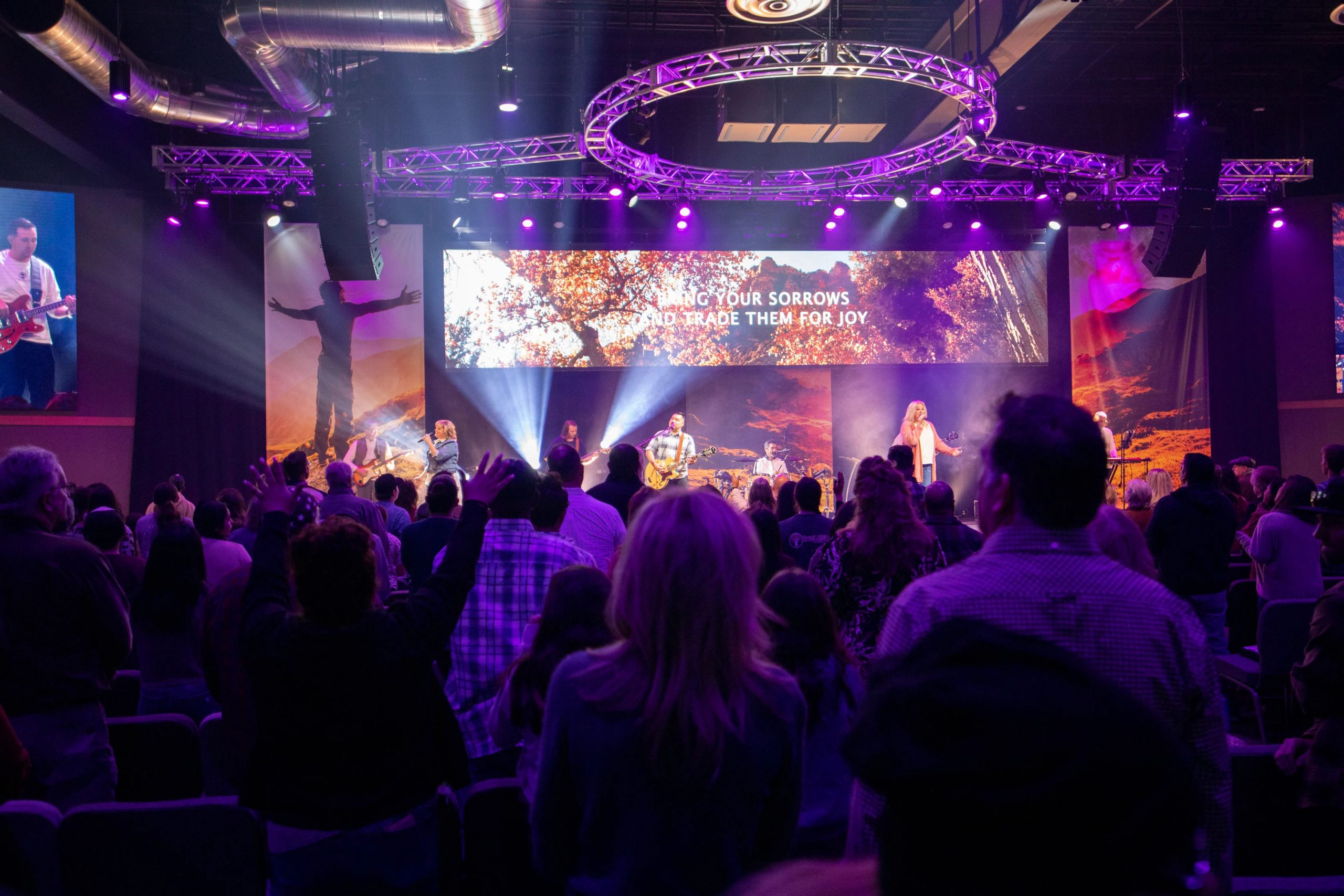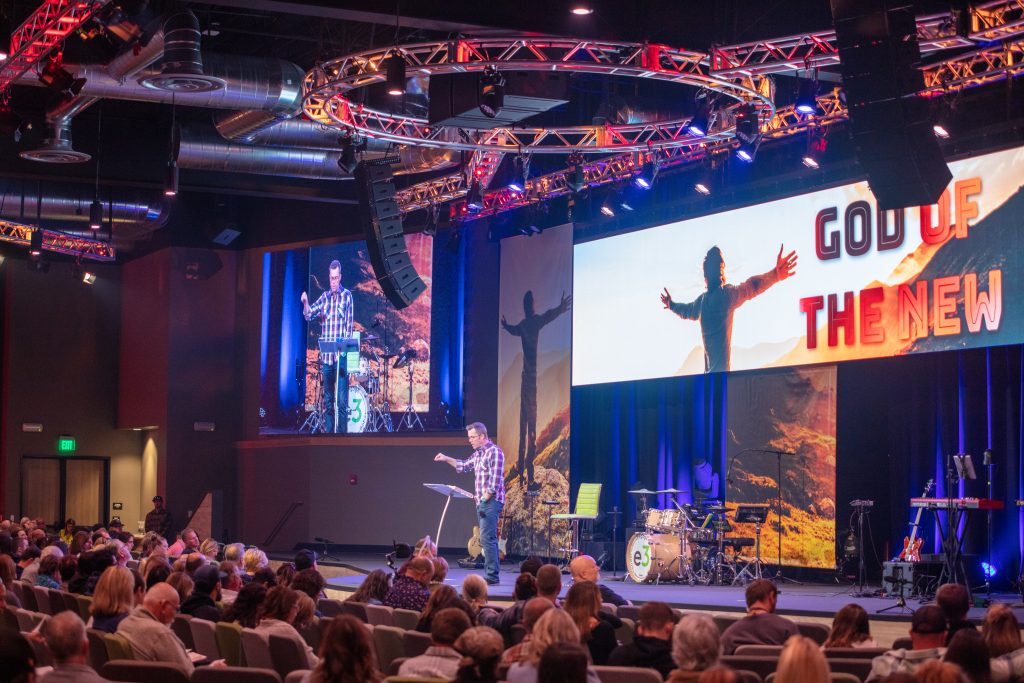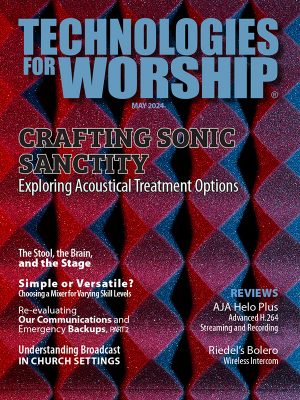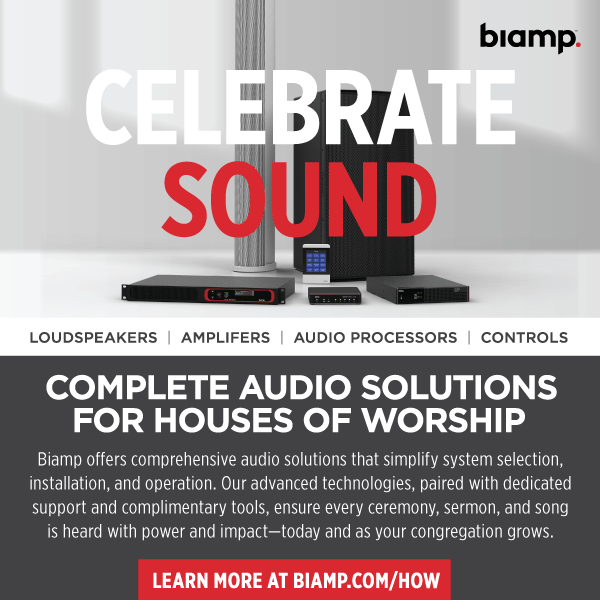
By Andres Caamano
When deciding on the right speakers for your worship space, there’s certainly no shortage of choices within the market.
Before diving into a particular model for your main PA, have a strong grasp on your new system’s goals.
Whether your worship space houses a couple of hundred or has a congregation into the thousands certain goals should apply. In addition, plan and account for how long you anticipate your new speakers will last. By doing such planning, you will avoid being boxed into a corner down the road. Setting aside some funds annually for the next speaker installment will avoid your having to take on a huge capital expense when another speaker install is necessary.
Other considerations for your space are whether to go with powered or passive speakers. As with any selection, there’ll be a mix of pros and cons. Understanding what will work best in your worship space is a crucial early step prior to making your final decision.
With the typical speaker size for many worship spaces the right choice shouldn’t be left to chance following an install. Beyond just size, various features should be considered as part of the speaker system, such as whether they’re Dante-enabled.
Upon deciding that you are going to move forward with an install, it makes sense to turn to an integrator. Doing a project correct the first time, versus going through multiple rounds to get it right, amounts to wise stewardship.
Aim For the Right Solutions, Not the Least Expensive Ones
With many available speaker models to consider, being focused on a low-bottom line in driving your decision may seem reasonable.
In discussing what direction a church should go, though, both Duke DeJong, president of integration at Vantage Pro, and David Leuschner, executive director at Digital Great Commission Ministries, pointed to a few solid manufacturers known for having a reputation in meeting a church’s needs.
For instance, in a small worship space, DeJong was a strong supporter of Martin Audio’s CDD series of speakers. The models within the line begin with a 5-inch differential dispersion speaker, up to 15 inches. “For 50 to 100 feet, I think the CDD series sounds great,” he said. “They have differential dispersion which is great and work for many worship spaces.” For alternatives to the CDD line within small spaces, DeJong said, “It’s hard to justify spending more. The CDD works so darn good, but there is also the Meyer Sound X40. They are a lot more money but are phenomenal sounding speakers.”
Detailing available small space options, Leuschner acknowledged many smaller churches often “lean more toward low-budget options.” In such cases, “you might look at QSC or Martin.” Fortunately, Leuschner said aside from those manufacturers, d&b audiotechnik, L-Acoustics, JBL and Meyer “make low budget to high budget items.” Speaking of the range offered by just one manufacturer, Leuschner said, “For Meyer, they make some speakers on a stick. Along with d&b, they also tend to be a top high-end speaker choice. We can argue which sound better than the other. It often comes down to budget.”
For Midsize Spaces, Look to Arrayable Speakers
For churches large enough where speakers on mounting poles would not provide satisfactory coverage, look to array setups.
Prospects worthy of consideration, explained DeJong, include the L-Acoustics A-Series. Part of that series are the two-way passive speakers, the A10i Focus and A15i Focus. The max sound pressure level, or SPL, achievable by the A10i is 140 dB; the A15i can reach 144 dB. Aside from L-Acoustics, DeJong also deemed another A-series, manufactured by d&b, either the AL60 or AL90, as impressive choices. According to DeJong, another model of note for such a space is Martin Audio’s TORUS. Between each of these speakers, he said, “They are all designed to be arrayable products for 50 to 100 feet. The coverage is consistent within the speaker patterns, and generally they sound very good, which is important.”
Among the various options between the three manufacturers, DeJong cited a preference with L-Acoustics in such an arrangement. “They’re all in the same neighborhood (for cost). What we’ve seen with L-Acoustics, though, they tend to be slightly more cost effective; however, that’ll depend on the configuration. For instance, it depends on whether you’ll need side fills, balcony fills, sub fills or front fills.”
In considering the right speakers for a midsize space, Leuschner again referenced the manufacturers he deemed ideal in smaller spaces. He highlighted how each manufacturer offers products that are matched for those slightly larger spaces. For the brand he most considers on such installs, he said, “I’ll typically turn to L-Acoustics, and their lower-end products. Or JBL, Martin, d&b, and the lower-tier speakers that they offer.”
Ideal Speaker Options for Largest Spaces
If your worship space houses 1,500 or more, it’s likely you’ll plan to use one of the most powerful speaker options.
For larger space installs, L-Acoustics and Meyer Sound were again highlighted by DeJong and Leuschner as ideal selections.
As detailed by DeJong, “We’re big fans of KARA. The K-3 is also phenomenal. The big difference between the two is the SPL, or overall horsepower and the handling of low frequencies. The KARA will be great, unless they need a very high SPL, or need more energy.” What are the differences between the two? As he described, “the K-3 is relatively new. They needed something between the KARA and the K-2. For those who might be saying, ‘I don’t need a full K-2 rig,’ the K-3 is a nice middle ground.”
In addition, DeJong noted “d&b has some great line array options.” Another solid choice, he said “sounds great,” is Meyer Sound’s LEOPARD series. When making a decision, DeJong had one last question, “for these line array solutions, how loud do you need it?”
When referencing which manufacturers to turn to in a larger worship space, Leuschner agreed with DeJong, by suggesting Meyer Sound, d&b, and L-Acoustics. In terms of specific models, Leuschner said, “It all comes down to room size, and you could use L-Acoustics’ LINA. You can do a lot with them, depending on the room size.” From his experience issues often arise when a church with a large worship space opts to “go with an unfamiliar model … that’s most often when they get upset.”
Planning, Prior to Selecting the Speaker Model
Early on when choosing a speaker it helps to firm up what goals the new speakers seek to fulfill. For DeJong, one of the primary goals he deems a speaker system should achieve relates to “consistency in coverage.” That consistency ought to be experienced “side to side and from front to back. That should be a top priority – at the very least it should be similar.” For Leuschner, he cited not only coverage, but also decibel levels. “You have to accomplish both goals. From covering the whole room, to having a decibel level that works for your church,” he said.
Determining the right speaker for your space is by no means guesswork. Don’t be looking to install a set of speakers, hoping they’re the right ones. DeJong shared, “We have a solid idea about how good the coverage will be in the space. When we are looking at a venue the first time, it helps building it with modeling software. Whether it’s L-Acoustics’ Soundvision (sound designing and mapping tool) or EASE, we can see what will fit the room.”
Using such software tools, explained Leuschner, “allows you to see what the speaker can do in your space.” With the tools offered by d&b, Meyer or L-Acoustics, a useful feature includes “moving a virtual microphone throughout the room. It allows you to see what the speaker sounds like (in the space).” For less expensive speakers, they often don’t offer such customized tools. One can use EASE in those instances, which while useful, “may not be as flexible as the proprietary ones.”
Finding the Right Speaker, Accounting for Options
Among the many choices of features existing within a set of speakers, how they are powered, is an important consideration. For instance, would you opt for passive (nonpowered) speakers, or those with amps housed internally? As outlined by DeJong, among the pros for powered units are that the speakers and amps are typically matched. The sound from such a system adds up to an optimized result. Among his cons, though, is by having the power “located in the ceiling, it’s a negative with maintenance. And it will be harder to troubleshoot.” For nonpowered speakers, power is then often in a rack, making any maintenance often simpler to handle. Without a matched amplifier paired specifically to the speaker, though, “your sound can be less than optimal.”
Regarding the location of the power Leuschner took a different view. “If you’re using powered speakers, you don’t need an amp room, and therefore can save money.” If opting for passive speakers, though, anticipate the built-in added cost of “an amp room and air conditioning.”
Another consideration in making a decision on a particular speaker is whether to have them be Dante-enabled. On that topic, Leuschner and DeJong also had differing viewpoints. In the eyes of Leuschner, “Dante is a necessary and a must. While you can get along with an analog connection, if you want to futureproof things, it’s a good thing to do.”
One scenario where having Dante could be problematic, he cautioned, was “if you have no volunteers” to confidently operate Dante. In such an instance, it may be best to go with “an analog connection.” DeJong considers Dante “a convenience (in installed configurations). In a portable application, they are important, as they will probably be repatched and reprogrammed on a regular basis.”
Looking Ahead to the Next Install
For church leadership, the investment in a worship space’s new speakers isn’t typically viewed as a short-term one. The question is how long should you anticipate the lifespan play out for the new speaker system? As noted by DeJong, “the general rule with audio gear, is seven to 10 years for a lifespan.” He then quickly added, “a well-kept audio system, though, will often last longer.”
Leuschner qualified his lifespan answer based on the degree of investment. “Certain manufacturers will last longer than others. You can get 10 to 15 years out of (a particular speaker model). For less expensive ones, they often will start to fail in five to seven years.” Another differentiation Leuschner outlined was, when buying new, how “new” is the technology that exists in the speaker? “Technology progresses year to year. If you buy a speaker with technology that’s five years old it’s not going to sound as good as a new product line speaker full of new innovations.”







